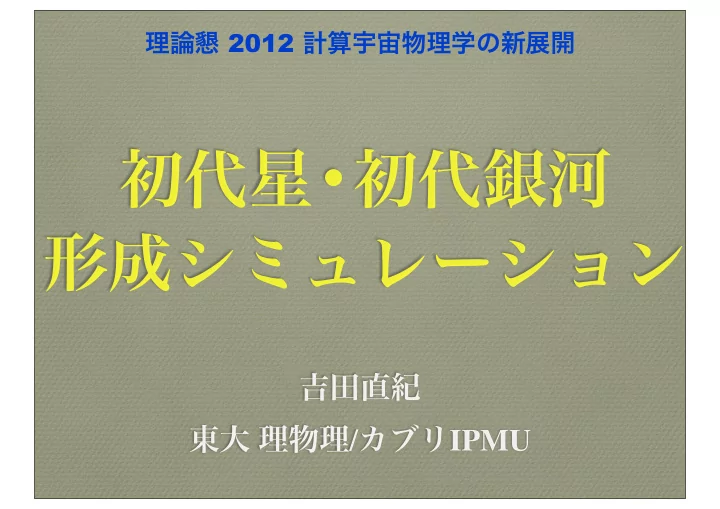

初代星•初代銀河 形成シミュレーション 吉田直紀 理論懇 2012 計算宇宙物理学の新展開 東大 理物理 / カブリ IPMU
Contents ✦ Early universe simulations ✦ The primordial IMF ✦ Technical challenges and the future References & collaborators: Bromm & NY, 2011, Annual Review of Astronomy & Astrophysics Greif, Bromm, Clark, Glover, Klessen, NY, Springel, 2012, MN Smith, Iocco, Glover, Schleicher, Klessen, Hirano, NY, 2012, ApJ Naoz, NY, Gnedin 2011, ApJ Naoz, NY, Gnedin 2013, ApJ in press Hosokawa, NY, Omukai, Yorke, 2011 Science; 2012 ApJL Hirano & NY 2013, ApJ in press Chiaki, Nozawa, NY, in preparation Hirano, Hosokwa et al in preparation
Most distant galaxy z ~ 9.6 t~500 Myrs 星形成効率 電離光放出•脱出率 (大内講演)
Stellar relics in the MW A forbidden star extremely metal-poor (not only iron-poor) Caffau et al. 2012 (千秋ポスター参照) Low-mass (<1 M sun ), Z < 4.5 x 10 -5 Z sun
Theory
STANDARD COSMOLOGICAL MODEL THEORY OF STAR FORMATION 4% 22% 74% molecular cloud protostar star dark matter early structure inflation
Putting the early universe on a computer
chemistry radiation cosmology dark matter “Egli è scritto in lingua matematica” - Galileo Galilei
Gravity: dark matter web 2 trillion-particles resolution (石山講演)
Hydrodynamics An example of a moving mesh sim (Greif+11) (+輻射圧)
Chemistry + ~50反応式 (>100 if with C, O etc)
Radiative transfer 分子線輸送と高密度領域でのエネルギーロス H 2 -He, H 2 -H 2 , H 2 -H 衝突による赤外光放出 密度、温度、分子率、形状の関数 ~200 レベル遷移
Hirano & NY, 2013, ApJ 3D Structure of a disk: with/without radiative transfer 3D effect important in post-collapse simulations efficiency cooling line continuum
Supersonic stream Relative motions between gas and dark matter Tseliakhovich & Hirata 2011; Visbal+ 12; Naoz, NY, Gnedin 11,12
Multi-component ICs NY, Sugiyama, Hernquist 2003, MN Perturbation evolution: theory vs simulations
Effect on early structure Gas fraction Naoz, NY, Gnedin 2011;2013 Filtering mass prescription
Pre-collapse phase Inside-out, in a self-similar fashion density velocity 1 solar radius 1AU The mass of the new-born protostar ~ 0.01 M sun Dark matter plays little role after run-away collapse (unless DM annihilates)
Post-collapse phase Greif, Bromm, Clark, Glover, Smith, Klessen, NY, Springel, 2012 Early evolution of the proto-stellar disk Small fragments are merged onto the central protostar on an orbital time scale “Gravo-viscous accretion”
The Key Question How and when does a first star stop growing ? 明確な予言が必要
Protostellar evolution to main-sequence H II region break-out Radiation-hydro. calculation (既 細川講演) Ionizing photon transfer by ray-tracing, continuum (H - ) by Flux Limited Diffusion. H. Yorke’s code + non-eq. chemistry. Initial condition taken from our cosmological run.
Accretion vs evaporation Photo-dissociation Final mass Hosokawa, Omukai, NY, Yorke, 2011, Science Accretion rate onto the protostar Cloud evaporation
Long standing puzzle resolved Observed elemental abundances Core-collapse SN models of 20-40 M sun progenitor Abundance pattern from a 25 Msun Hypernova model [Fe/H] < -5 Iwamoto et al. 2005
Primordial IMF
“Cosmic variance”
“Cosmic variance”
Toward Primordial IMF S. Hirano+ in prep. A sample of gas clouds
S. Hirano+ in prep. Mass distribution
( 計算物理的 ) Future Dark matter: 0.1-1 trillion particles Chemistry : non-eq. ⇄ eq ⇄ non-eq. Radiative transfer: line (OK), infrared (FLD?), ionizing UV (ray-tracing) Protostar structure rotation, surface structure 現象として難しい部分が出てくるだろう Gas : with refinements down to R sun
Future development 1 Adding weak B-field Turk+12 Small-scale dynamo in action
Future development 2 Post III.1, e.g. III.2 Hosokawa, NY, Omukai, Yorke, ApJL, 2011
Chemo-Thermal Instability Q gets larger than 1, but not much larger. Q=収縮時間/成長時間 Perturbation analysis 個人的に気掛かりな事 d ∝ exp( w t ) Collapse is just ‘chemo- thermally’ accelerated. (NY, Omukai 06) Needs to be revisited with extreme resolutions
III.1 vs III.2 The initial accretion rate is smaller in III.2 (owing to HD cooling). KH contraction begins earlier, at a small stellar mass. But ionizing luminosity increases quickly. → Growth halted early at M ~ 10 M sun
Future development 3 Chiaki, NY, Kitayama, 2013 Early SN remnant with 10 -5 Z sun Fragmentation of a cooling shell Cooling by dust テキスト HD cooling SN remnant Low - metallicity star formation → first galaxies
Yet another direction Smith+12, ApJ Supersymmetric dark matter density dark matter heating Heating and disk fragmentation 10 6 10 8 10 10 10 12 10 14 10 16
まとめ なった (日本の力) 次の目標はfull 3D 珍しくcomputer power limited な物理が必要 (重元素、ダスト、磁場、乱流) 最初の試みがなされつつある が必要(つまりあと10年) • 初代原始星進化•形成の全体を追えるように • 初代銀河のシミュレーションにはさらに複雑 • TMT/JWST/SKA の時代には明確な理論予言
Recommend
More recommend